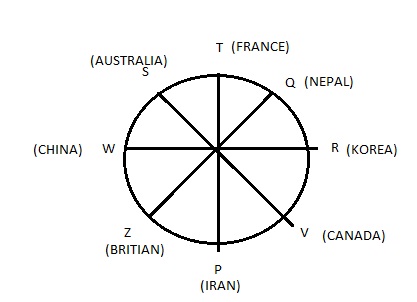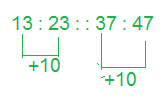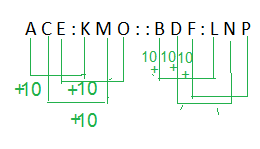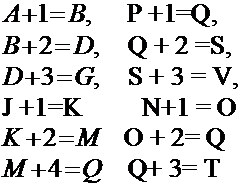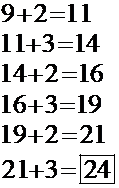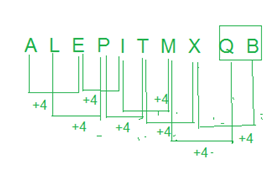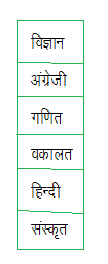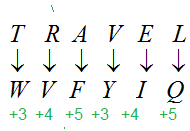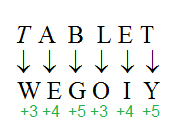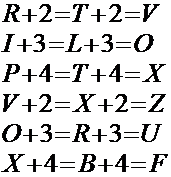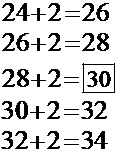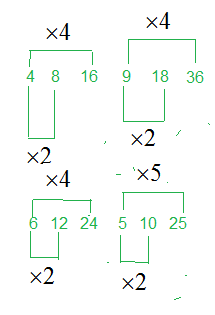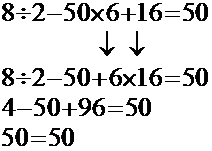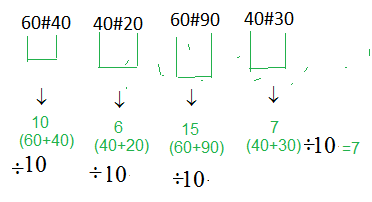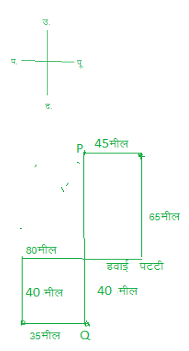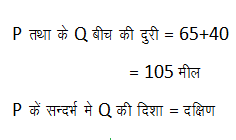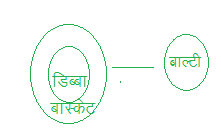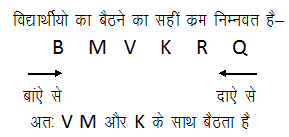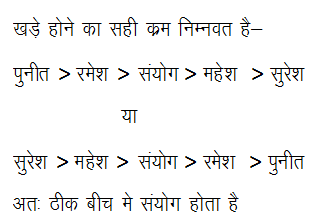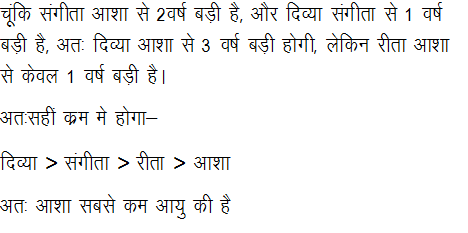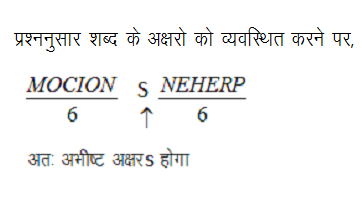
If only conclusion
I follows.
a. If only conclusion I
follows.
b. If only conclusion II
follows.
c. If either conclusion I or
II follows.
d. If neither conclusion I
nor II follows
e .If both conclusion I and II follow.
a. If only conclusion I
follows.
b. If only conclusion II
follows.
c. If either conclusion I or
II follows.
d. If neither conclusion I
nor II follows
e .If both conclusion I and II follow.
a. If only conclusion I
follows.
b. If only conclusion II
follows.
c. If either conclusion I or
II follows.
d. If neither conclusion I
nor II follows
e .If both conclusion I and II follow.
a. If only conclusion I
follows.
b. If only conclusion II
follows.
c. If either conclusion I or
II follows.
d. If neither conclusion I
nor II follows
e .If both conclusion I and II follow.
Directions (6--10): Read the following information carefully to answer the given questions.
In a global environment summit, eight representatives, viz P, Q, R, S, T, V, W and Z are representing different countries, viz Australia, Canada, France, Iran, China, Korea, Nepal and Britain, but not necessarily in the same order.
All of them are sitting around a circular table facing the centre.
V sits third to the left of T. R and Z and also their immediate neighbours do not represent France. Only one person sits between W and the representative of France. The representatives of Iran and Canada are immediate neighbours of each other. R represents neither China nor Iran. Only one person sits between P and the one who represents Korea. P does not represent either France or Canada. R sits third to the right of Z. Z represents Britain. T is not an immediate neighbour of either R or Z. The one who represents Australia is an immediate neighbour of T. Three people sit between Z and the representative of Nepal. Q is not representing either France or Australia.
Who among the following represents Canada?
a) Q
b) R
c) T
d) V
e) Cannot be determined
Directions (6--10): Read the following information carefully to answer the given questions.
In a global environment summit, eight representatives, viz P, Q, R, S, T, V, W and Z are representing different countries, viz Australia, Canada, France, Iran, China, Korea, Nepal and Britain, but not necessarily in the same order.
All of them are sitting around a circular table facing the centre.
V sits third to the left of T. R and Z and also their immediate neighbours do not represent France. Only one person sits between W and the representative of France. The representatives of Iran and Canada are immediate neighbours of each other. R represents neither China nor Iran. Only one person sits between P and the one who represents Korea. P does not represent either France or Canada. R sits third to the right of Z. Z represents Britain. T is not an immediate neighbour of either R or Z. The one who represents Australia is an immediate neighbour of T. Three people sit between Z and the representative of Nepal. Q is not representing either France or Australia.
Who among the following represent immediate neighbours of V?
A) P, Q
B) P, S
C) T, W
D) P, R
E) P and the representative of China.
Directions (6--10): Read the following information carefully to
answer the given questions.
In a global environment summit, eight representatives, viz P, Q,
R, S, T, V, W and Z are representing different countries, viz Australia,
Canada, France, Iran, China, Korea, Nepal and Britain, but not necessarily in
the same order.
All of them are sitting around a circular table facing the centre.
V sits third to the left of T. R and Z and also their immediate
neighbours do not represent France. Only one person sits between W and the
representative of France. The representatives of Iran and Canada are immediate
neighbours of each other. R represents neither China nor Iran. Only one person
sits between P and the one who represents Korea. P does not represent either
France or Canada. R sits third to the right of Z. Z represents Britain. T is
not an immediate neighbour of either R or Z. The one who represents Australia
is an immediate neighbour of T. Three people sit between Z and the
representative of Nepal. Q is not representing either France or Australia.
Which of the following is true regarding W?
A)W sits second to the right of P.
B)W represents Iran.
C)W sits between Q and the representative of Britain.
D)Only one person sits between W and the representative of Canada.
E)None is true
Directions (6--10): Read the following information carefully to
answer the given questions.
In a global environment summit, eight representatives, viz P, Q,
R, S, T, V, W and Z are representing different countries, viz Australia,
Canada, France, Iran, China, Korea, Nepal and Britain, but not necessarily in
the same order.
All of them are sitting around a circular table facing the centre.
V sits third to the left of T. R and Z and also their immediate
neighbours do not represent France. Only one person sits between W and the
representative of France. The representatives of Iran and Canada are immediate
neighbours of each other. R represents neither China nor Iran. Only one person
sits between P and the one who represents Korea. P does not represent either
France or Canada. R sits third to the right of Z. Z represents Britain. T is
not an immediate neighbour of either R or Z. The one who represents Australia
is an immediate neighbour of T. Three people sit between Z and the
representative of Nepal. Q is not representing either France or Australia.
How many persons sit between S and the representative of Iran, when counted anticlockwise from S?
A) None
B) One
C) Two
D) Three
E) Four
Directions (6--10): Read the following information carefully to
answer the given questions.
In a global environment summit, eight representatives, viz P, Q,
R, S, T, V, W and Z are representing different countries, viz Australia,
Canada, France, Iran, China, Korea, Nepal and Britain, but not necessarily in
the same order.
All of them are sitting around a circular table facing the centre.
V sits third to the left of T. R and Z and also their immediate
neighbours do not represent France. Only one person sits between W and the
representative of France. The representatives of Iran and Canada are immediate
neighbours of each other. R represents neither China nor Iran. Only one person
sits between P and the one who represents Korea. P does not represent either
France or Canada. R sits third to the right of Z. Z represents Britain. T is
not an immediate neighbour of either R or Z. The one who represents Australia
is an immediate neighbour of T. Three people sit between Z and the
representative of Nepal. Q is not representing either France or Australia.
Which of the following is true?
A)S represents France.
B)Only one person is sitting between the representatives of Iran and China.
C)The reperesentative of Canada is an immediate neighbour of W.
D)One person sits between Z and the representative of France.
E)None is true
Directions (Q.11--13): Read the information carefully to answer the
given questions.
Seven boys are made to stand in a row in
increasing order of their height (shortest boy first). Their names are Akash,
Anup, Kishan, Raj, Sumit, Keshav and Jai.
Sumit is the tallest boy among them.
Keshav stands between Akash and Raj. There are exactly three boys between Raj
and Anup. Jai comes right after Sumit in height.
How many arrangements are possible
according to the given information?
A) One
B) Two
C) Three
D) Four
E) None of these
Directions (Q.11-13): Read the information carefully to answer the given questions.
Seven boys are made to stand in a row in increasing order of their height (shortest boy first). Their names are Akash, Anup, Kishan, Raj, Sumit, Keshav and Jai.
Sumit is the tallest boy among them. Keshav stands between Akash and Raj. There are exactly three boys between Raj and Anup. Jai comes right after Sumit in height.
How many boys take the same position in the row in all the possible arrangements?
A) Two
B) Three
C) Four
D) Five
E) None of these
Directions (Q. 11-13): Read the information carefully to answer the
given questions.
Seven
boys are made to stand in a row in increasing order of their height (shortest
boy first). Their names are Akash, Anup, Kishan, Raj, Sumit, Keshav and Jai.
Sumit
is the tallest boy among them. Keshav stands between Akash and Raj. There are
exactly three boys between Raj and Anup. Jai comes right after Sumit in height.
If
Keshav is taller than Kishan, who is the shortest boy?
A)
Raj
B)
Akash
C)
Anup
D)
Kishan
E)
Can’t be determined
Directions(14--18):Study
the following information to answer the given questions
Eight students M,
N, O, P , U, V, W and X are sitting around a square table in such a way four of
them sit at four corners while four sit in the middle of each of the four
sides. The one who sit at the 4 corners face the centre and others facing
outside.
M who faces the
centre sits third to the left of V. U who faces the centre is not an immediate
neighbour of V. Only one person sits between V and W. P sits second to right of
N. N faces the centre. O is not an immediate neighbour of M.
a. Third to the right
b. Second to the left
c. Second to the right
d. Second to the right
e. None of these
Directions(14--18):Study
the following information to answer the given questions
Eight students M,
N, O, P , U, V, W and X are sitting around a square table in such a way four of
them sit at four corners while four sit in the middle of each of the four
sides. The one who sit at the 4 corners face the centre and others facing
outside.
M who faces the
centre sits third to the left of V. U who faces the centre is not an immediate
neighbour of V. Only one person sits between V and W. P sits second to right of
N. N faces the centre. O is not an immediate neighbour of M.
a. X
b. M
c. W
d. V
e. None of these
Directions(14--18):Study
the following information to answer the given questions
Eight students M,
N, O, P , U, V, W and X are sitting around a square table in such a way four of
them sit at four corners while four sit in the middle of each of the four
sides. The one who sit at the 4 corners face the centre and others facing
outside.
M who faces the
centre sits third to the left of V. U who faces the centre is not an immediate
neighbour of V. Only one person sits between V and W. P sits second to right of
N. N faces the centre. O is not an immediate neighbour of M.
a. W faces the centre
b. N faces outside
c. X faces inside
d. M faces the centre
e. None of these
निम्नलिखित प्रष्न मे दिए गए विकल्पो मे से
सम्बधित षब्द युग्म को चुनिए-
परिधि : वृत्त : : ? : ?
1 वर्ग : क्षेत्रफल
2 वर्ग : घनाभ
3 गोलाकार : वृत्त
4 परिमाप : आयत
लड़कियो के एक पंक्ति मे यदि सुजाता जोकि
बाए से 10 वी है, और नम्रता जोकि दाऐ से 9 वी है, अपना स्थान आपस मे बदलते है तो सुजाता बाऐं
से 15 वां हो जाती है, तो पंक्ति मे कितनी लड़किया है।
निम्नलिखित प्रश्न मे दिए गए विकल्पो मे से सम्बधित शब्द
संख्या को चुनिए-
13 : 23 : : 37 : ?
1 40
2 46
3 47
4 43
निम्नलिखित प्रश्न मे दिए गए विकल्पो मे से सम्बधित अक्षर/अक्षरो को चुनिए-
ACE : KMO :
: BDF : ?
1 LNO
2 MPO
3 LNP
4 NPQ
निम्नलिखित प्रश्न मे दिए गए विकल्पो मे से
विषम शब्द युग्म को चुनिए-
1 वाहन - कार
2 स्कुटर - वाहन
3 ट्रक - वाहन
4 बस - वाहन
नीचे दिऐ गऐ प्रश्न मे चार संख्या युग्म दिए गए है (-) के बायी ओर दी संख्या (-)के दांयी ओर दी गई संख्या से तर्क /नियम से संबंधित है, तीन उसी एक तर्क / नियम के आधार पर समान है, दिए गए विकल्पो मे से भिन्न को चुनिए-
1 7-49
2 9-81
3 11-121
4 15-215
निम्नलिखित मे दिऐ विल्कपो मे से विशम
अक्षर/अक्षरो को चुनिए-
1 ABDG
2 PQSV
3 JKMQ
4 NOQT
निम्नलिखित शब्दो को शब्दकोश मे आने वाले
क्रम के अनुसार लिखिए-a)Peanut
b) Peaceful c) Personal d) Photograph e) Picture
1 43125
2 21345
3 13245
4 32451
निम्नलिखित
मे दिए गए विकल्पो मे से लुप्त अंक ज्ञात कीजिए-
9, 11, 14, 16, 19, 21,
1
24
2
26
3
25
4
27
एक अनुक्रम दिया गया है, जिसमें से एक पद लुप्त है, दिए गए विकल्पो मे से वह सही विकल्प चुनिए
जो अनुक्रम को पुरा करें-
AL, EP, IT, MX, ?
1 RC
2 QB
3 QV
4 TV
पुस्तको को एक के ऊपर एक रखा गया है, हिन्दी,
संस्कृत के ठीक
ऊपर है अंग्रेजी गणित तथा विज्ञान के मध्य है, वकालत हिन्दी तथा गणित के मध्य है
कौन सी पुस्तक ऊपर से चौथे स्थान पर है?
1 गणित
2 वकालत
3 हिन्दी
4 अंग्रेजी
दिए गए विकल्पो मे से वह शब्द चुनिए जो दिए
गए शब्द के अक्षरो का प्रयोग करके नहीं बनाया जा सकता है-
Abettor
1 Bettor
2 Wrote
3 Rot
4 Abet
एक विशिष्ट कोड़ भाषा मे TRAVEL” को “WVFYIQ” लिखा जाता है, इस कोड भाषा मे TABLET” को किस प्रकार लिखा जाएगा
1 EWOGYN
2 NYOGYW
3 YGWPQM
4 WEGOIY
एक अनुक्रम दिया गया है जिसमें से एक पद लुप्त है, दिए गए विकल्पो मे से वह सही विकल्प चुनिए
जो अनुक्रम को पुरा करे-
RIP, TLT, VOX, XRB, ?
1 ZTE
2 AUF
3 ZUF
4 ATE
निम्नलिखित
प्रश्न मे दिए गए विकल्पो मे से लुप्त अंक ज्ञात कीजिए-
24 26 28 ? 32 34
नीचे दिए गए प्रश्न मे तीन संख्याओ के 4 समूह दिए गए है, प्रत्येक समूह मे दुसरी तथा तीसरी संख्या
पहली संख्या से किसी एक तर्क/नियम से संबंधित है, तीन उसी एक तर्क/नियम
के आधार पर समान है,दिए गए विकल्पो मे से भिन्न को चुनिए –
1 (4, 8, 16)
2 (9, 18, 36)
3 (6, 12, 24)
4 (5,10, 25)
निम्नलिखित समीकरण गलत है, इस समीकरण को सही करने के लिए किन दो
चिन्हो को आपस मे अदला-बदली करना चाहिए-
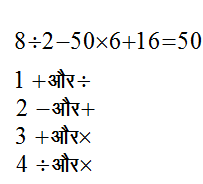
यदि 60#40
= 10, 40#20 =6 और
60#90 = 15 तो 40#30
= ? का मान ज्ञात कीजिए-
निम्नलिखित मे कौन सा पद दी गई सूची के
क्रम के अनुसार है?
ZYXYXYXY, XWXYXYXY, XYZYXYXY, XYXWXYXY
XYXYZYXY,………..
1 XYXYXWXY
2 XYXYXYXY
3 ZYXYXTXY
4 XWXYXYXY
दो
हवाई जहाज एक ही हवाई पट्टी से निकालते है हवाई जहाज P उत्तर की तरफ 65 मील तक उड़ता है फिर बाई
तरफ मुड़कर 45 मील की दुरी तक जाता है और नीचे उतर जाता है इस
बीच हवाई जहाज Q पश्चिम
की तरफ 40 मील तक उड़ता है, फिर अपने बाई तरफ
मुड़ जाता है 35 मील. की दुरी तक जाता है, और भुमि पर उतर जाता है। हवाई P जहाज के सन्दर्भ मे हवाई जहाज Q कहां है?
1 25 मील दक्षिण
2 105 मील उत्तर
3 26 मील उत्तर
4 105 मील दक्षिण
कथनः- 1 सभी डिब्बा
बास्केट होते है
2. कोई भी बाल्टी
डिब्बा नही होती
निष्कर्ष:
1. सभी बास्केट
बाल्टी होती है
2. सभी बाल्टी
बास्केट होती है
1 केवल निष्कर्ष 1 सही है
2 केवल निष्कर्ष 2 सही है
3 दोनो निष्कर्ष 1 और 2 सही है
4 न तो निष्कर्ष 1 सही है न ही निष्कर्ष 2
एक पंक्ति मे 6 विद्यार्थी बैठते है k,v,और r के बीच में बैंठता है V M के साथ बैठता है] M,B के साथ बैठता है] जो बांऐ से आखिरी मे बैंठा है] और Q,R के साथ बैठता है कौन से दो V के साथ बैठते है?
1 m और k
2 v और K
3 Q और r
4 R और K
महेsश सुरेश से लम्बा है संयोग महेश से लम्बा है रमेश संयोग से लम्बा है पुनीत सबसे लंबा है यदि वे अपनी ऊंचाईयो
के अनुसार खड़े होते है तो कौनसा ठीक -ठीक बीच मे खड़े होगा ?
1 संयोग
2 महेश
3 रमेश
4 पुनीत
दिव्या, संगीता, आशा, और रीता, चार मित्र है दिव्या संगीता से 1 वर्ष बड़ी है संगीता आशा से 2 वर्ष बड़ी है रीता आशा से 1 वर्ष बड़ी है,सबसे
कम आयु वाली कौन है
1 आशा
2 दिव्या
3 रीता
4 संगीता
यदि
“COMPREHENSION” शब्द के प्रथम तीन अक्षर उलट दिए जांए और अतिंम तीन अक्षरो को
जोड़ दिया जाए फिर बाकी बचे हुए अक्षरो को उल्टा कर जोड़ दिया जाए तो बिलकुल मध्य में कौन सा अक्षर होगा?
1 s
2 o
3 h
4 e
